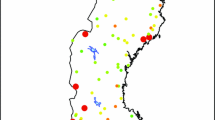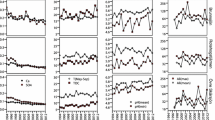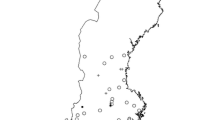Abstract
Over 7,000 lakes around Sudbury, Ontario, Canada were acidified by S deposition associated with emissions from the Sudbury metal smelters and more distant S sources. Air pollution controls have led to widespread changes in damaged Sudbury lakes, including increased pH and decreased concentrations of SO4, metals and base cations. While chemical improvements have often been substantial, many lakes are still acidified, although water quality recovery is continuing. Biological recovery has been observed in some lakes among various groups of organisms including fish, zooplankton, phytoplankton and zoobenthos. Generally, however, biological recovery is still at an early stage. Lakes around Sudbury are also showing that the recovery of acid-damaged lakes is closely linked to the effects of other major environmental stressors such as climate change, base cation depletion and UV-B irradiance. Future studies of the recovery of acid-damaged lakes around Sudbury, and in other regions, will need to consider the interactions of these and other stressors.





Similar content being viewed by others
References
Arnott, S. E., Yan, N., Keller, W., & Nicholls, K. (2001). The influence of drought-induced acidification on the recovery of plankton in Swan Lake (Canada). Ecological Applications, 11, 747–763.
Borgmann, U. (2003). Derivation of cause–effect based sediment quality guidelines. Canadian Journal of Fisheries and Aquatic Sciences, 60, 352–360.
Findlay, D. L. (2003). Response of phytoplankton communities to acidification and recovery in Killarney Park and the Experimental Lakes Area, Ontario. Ambio, 32, 190–195.
Gunn, J. M., & Keller, W. (1990). Biological recovery of an acid lake after reductions in industrial emissions of sulphur. Nature, 345, 431–433.
Havas, M., Woodfine, D. G., Lutz, P., Yung, K, MacIsaac, H. J., & Hutchinson, T. C. (1995). Biological recovery of two previously acidified, metal-contaminated lakes near Sudbury, Ontario, Canada. Water, Air and Soil Pollution, 85, 791–796.
Holt, C., & Yan, N. D. (2003). Recovery of crustacean zooplankton communities from acidification in Killarney Park, Ontario, 1971–2000: pH 6 as a recovery goal. Ambio, 32, 203–207.
Keller, W., Dillon, P. J., Heneberry, J., Malette, M., & Gunn, J. M. (2001b). Sulphate in Sudbury, Ontario, Canada lakes: Recent trends and status. Water, Air, and Soil Pollution, 130, 793–798.
Keller, W., Dixit, S. S., & Heneberry, J. (2001a). Calcium declines in northeastern Ontario lakes. Canadian Journal of Fisheries and Aquatic Sciences, 58, 2011–2020.
Keller, W., Gunn, J. M., & Yan, N. D. (1999b). Acid rain – perspectives on lake recovery. Journal of Aquatic Ecosystem Stress and Recovery, 6, 207–216.
Keller, W., Heneberry, J. H., & Dixit, S. S. (2003). Decreased acid deposition and the chemical recovery of Killarney, Ontario, lakes. Ambio, 32, 183–189.
Keller, W., Heneberry, J., & Gunn, J. M. (1999a). Effects of emission reductions from the Sudbury smelters on the recovery of acid and metal-damaged lakes. Journal of Aquatic Ecosystem Stress and Recovery, 6, 189–198.
Keller, W., Heneberry, J. H., & Leduc, J. (2005). Linkages between weather, dissolved organic carbon, and cold-water habitat in a Boreal Shield lake recovering from acidification. Canadian Journal of Fisheries and Aquatic Sciences, 62, 340–346.
Keller, W., & Pitblado, J. R. (1986). Water quality changes in Sudbury area lakes: A comparison of synoptic surveys in 1974–76 and 1981–83. Water, Air, and Soil Pollution, 29, 285–296.
Keller, W., Pitblado, J. R., & Carbone, J. (1992). Chemical responses of acidic lakes in the Sudbury, Ontario, area to reduced smelter emissions, 1981–1989. Canadian Journal of Fisheries and Aquatic Sciences, 49(Suppl. 1), 25–32.
Keller, W., & Yan, N. D. (1991). Recovery of crustacean zooplankton species richness in Sudbury area lakes following water quality improvements. Canadian Journal of Fisheries and Aquatic Sciences, 48, 1635–1644.
Keller, W., & Yan, N. D. (1998). Biological recovery from lake acidification: Zooplankton communities as a model of patterns and processes. Restoration Ecology, 6, 364–375.
Keller, W., Yan, N. D., Somers, K. M., & Heneberry, J. H. (2002). Crustacean zooplankton communities in lakes recovering from acidification. Canadian Journal of Fisheries and Aquatic Sciences, 59, 726–735.
Neary, B. P., Dillon, P. J., Munro, J. R., & Clark, B. J. (1990). The acidification of Ontario lakes: An assessment of their sensitivity and current status with respect to biological damage (Tech. Rep., p. 171). Dorset, Ontario, Canada: Ontario Ministry of Environment.
Nicholls, K. H., Nakamoto, L., & Keller, W. (1992). Phytoplankton of Sudbury area lakes (Ontario) and relationships with acidification status. Canadian Journal of Fisheries and Aquatic Sciences, 49(Suppl. 1), 40–51.
Pollard, H. G., Colbourne, J. C., & Keller, W. (2003). Reconstruction of centuries-old Daphnia communities in a lake recovering from acidification and metal contamination. Ambio, 32, 214–218.
Schindler, D. W., Curtis, P. J., Parker, B. R., & Stainton, M. P. (1996). Consequences of climate warming and lake acidification for UV-B penetration in North American boreal lakes. Nature, 379, 705–708.
Snucins, E. (2003). Recolonization of acid damaged lakes by the benthic invertebrates Stenacron interpunctatum, Stenonema femoratum, and Hyalella azteca. Ambio, 32, 225–229.
Vander Zanden, J., Wilson, K. A., Casselman, J. M., & Yan, N. D. (2004). Species introductions and their impacts in North American Shield lakes, Chapter 13. In J. M. Gunn, R. J. Steedman, & R. A. Ryder (Eds.), Boreal shield watersheds – lake trout ecosystems in a changing environment. Boca Raton: CRC.
Watson, G., Hunt, C., & Keller, W. (1999). Natural and enhanced aquatic ecosystem development at Inco’s former Garson 10.2 open pit mine, p. 419–428. In D. Goldsack, N. Belzile, P. Yearwood, & G. Hall (Eds.), Proceedings mining and the environment II. Sudbury, Ontario.
Yan, N. D., Girard, R., Heneberry, J., Keller, W., Gunn, J., & Dillon, P. J. (2004). Recovery of copepod, but not cladoceran, zooplankton from severe and chronic effects of multiple stressors. Ecology Letters, 7, 452–460.
Yan, N. D., Keller, W., Scully, N. M., Lean, D. R. S., & Dillon, P. J. (1996a). Increased UV-B penetration in a lake owing to drought-induced acidification. Nature, 382, 141–143.
Yan, N. D., Keller, W., Somers, K. M., Pawson, T. W., & Girard, R. G. (1996b). Recovery of crustacean zooplankton communities from acid and metal contamination: Comparing manipulated and reference lakes. Canadian Journal of Fisheries and Aquatic Sciences, 53, 1301–1327.
Yan, N. D., Leung, B., Keller, W., Arnott, S. E., Gunn, J. M., & Raddum, G. G. (2003). Developing conceptual frameworks for the recovery of aquatic biota from acidification. Ambio, 32, 165–169.
Acknowledgements
This paper is a contribution from the Aquatic Restoration Group of the Cooperative Freshwater Ecology Unit, a partnership between Laurentian University, the Ontario Ministry of the Environment, the Ontario Ministry of Natural Resources, CVRD Inco (formerly Inco Ltd.), Xstrata Nickel (formerly Falconbridge Ltd.), and Environment Canada.
Author information
Authors and Affiliations
Corresponding author
Rights and permissions
About this article
Cite this article
Keller, W., Yan, N.D., Gunn, J.M. et al. Recovery of Acidified Lakes: Lessons From Sudbury, Ontario, Canada. Water Air Soil Pollut: Focus 7, 317–322 (2007). https://doi.org/10.1007/s11267-006-9061-2
Published:
Issue Date:
DOI: https://doi.org/10.1007/s11267-006-9061-2




